Mauve is every fashionista’s secret love.
Hidden between violet and pink on the color wheel, this delicate, bluish purple color has a great story.
A story of Colonial India, deadly mosquitoes and serendipity.
Although the French gave the color its etymological name, mauve, after the mallow flower, a young British chemist William Henry Perkin is credited with the commercial production of the synthetic dye while he was solving a major problem.
The year was 1856. To solve one of the biggest problems facing the British Raj, Perkin was conducting an experiment at the Royal College of Chemistry, London. The story takes us to the heart of the British empire – India.
Malaria, a deadly mosquito-borne disease, was a serious and often fatal threat to British colonists in India. It claimed the lives of both soldiers and civilian officials. Quinine powder quickly proved essential to the empire’s survival.
It is estimated that in the 1840, 700 tons of cinchona bark was consumed annually by British residents and soldiers in India for its protective dose of quinine. The miraculous Cinchona bark became the Empire’s secret weapon.
The creation of the Gin & Tonic, as it is no secret for liquor connoisseurs, was largely due to British soldiers stationed in India coming up with an improvised way to consume the intensely bitter Quinine powder. But that’s a story for another day.
In the cloud forests of the eastern Andes, which connect Bolivia, Ecuador and Peru, lived Cinchona, the only source of quinine in the world. Formerly called “Peruvian bark,” it is best known as a “miracle” treatment for malaria.
However, the drug was expensive and scarce because it came from far away in South America and required a labor-intensive extraction technique. The Empire needed an alternative solution.
Perkin, then 18 years old, was trying to solve this problem with the help of his professor, August William von Hofmann, who had a hypothesis. Young Perkin was determined to synthesize Quinine in his makeshift laboratory. It all came down to one failed experiment.
He made his most crucial yet accidental discovery at this point: one day, his failed experiment yielded a crude combination which, when extracted with alcohol, produced a material of a vivid purple color. Perkin saw enormous potential.
Although he was unable to synthesize quinine, he accidentally discovered one of the first synthetic dyes that was also commercially viable. He gave it the name Mauveine, which quickly gained popularity as the modern shade of Mauve.
Thus the flourishing color that swept the fashion industry for decades was born, as a result of a dreadful epidemic caused by mosquitos in Colonial India and a failed quest for a panacea.
Sources:
- Kim Walker, The cinchona tree, malaria and colonisation, Wellcome Collection, https://wellcomecollection.org/articles/YlWWVBAAACIAfkjd
- KAL RAUSTIALA,The Imperial Cocktail, Slate, https://slate.com/technology/2013/08/gin-and-tonic-kept-the-british-empire-healthy-the-drinks-quinine-powder-was-vital-for-stopping-the-spread-of-malaria.html
- Matthew Wills, The Accidental Invention of the Color Mauve, https://daily.jstor.org/the-accidental-invention-of-the-color-mauve/
Image Attributes:
- British India six stages of malaria, Wellcome Collection gallery, CC-BY-4.0 from Wikimedia.
- Advertisements for quinine sulphate, Wellcome Collection gallery, CC-BY-4.0 from Wikimedia.
- Mallow wildflower, CC BY-SA 3.0 from Wikimedia.
- ‘Quinine the only cure for malaria’, Philatelic Museum, General Post Office, Kolkata. © Rohan Deb Roy 2017 CC-BY-NC-ND 4.0
- https://digital.sciencehistory.org/works/o2sfuyr




